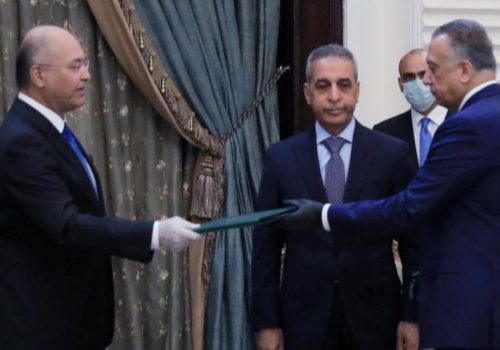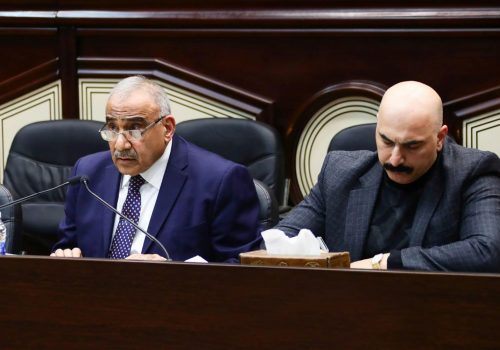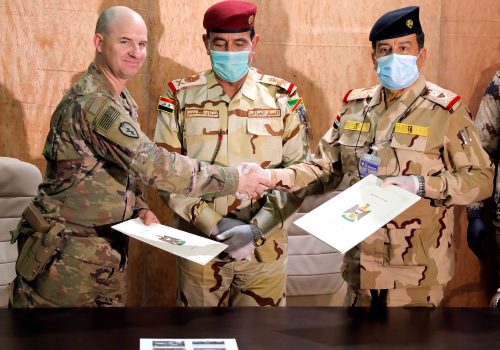Kadhimi’s moment: Controlling Iraq’s militias
The July 6 assassination of Hisham al Hashimi, a well-known political analyst who criticized Iraq’s sectarian politics, represented the loss of someone who made meaningful contributions to Iraq’s recovery and reconciliation efforts. Hashimi’s death also represented an escalation that threatens to bring back the gang-like violence Iraq experienced from 2004 to 2008.
No one has claimed responsibility for Hashimi’s murder. Many suspect Kitaib Hizballah (KH), a militia which is part of the Popular Mobilization Forces (PMF) backed by Iran. Hashimi was critical of KH and they reportedly sent him death threats just prior to his killing. Such murders of course, are not out of character for KH or any of Iran’s proxies in Iraq. They, along with Sunni extremists, were responsible for killing thousands of Iraqis during the years of sectarian conflict. More recently, these militias were responsible for killing, kidnapping, and torturing protesters, who objected, in-part, to Iran’s pervasive and malign influence in Iraq.
In Hashimi’s case, there is additional context that makes KH’s responsibility for his death plausible. Hashimi was supportive of Iraqi Prime Minister Mustafa Kadhimi, who in June had ordered members of KH detained. It should not be surprising then that many are taking Hashimi’s assassination as a message to Kadhimi: Stop interfering with the militias and their criminal operations.
The difficulty for Kadhimi is that even a strong suspicion of KH culpability is not enough to make further escalation against the militia appear legitimate to the Iraqi people. In fact, KH was not only able to get all their members arrested in the June raid released in 24 hours, they made a public show of welcoming them back publicly as heroes while burning American flags and tramping on images of Kadhimi. Further, it is important to remember that while the case against KH may seem compelling from the outside, it is not so from the inside. Hashimi was an outspoken critic of a range of Iraqi actors and had an extensive list of enemies. Thus, any moves Kadhimi makes against any suspected group without resolving uncertainty regarding their responsibility in a way the Iraqi public will accept will almost certainly escalate the violence.
Having said that, Hashimi’s assassination may provide Kadhimi with an opportunity to act. As the protests have illustrated, Iraqis are unhappy with the militias and Iran’s interference. The prospect of another sectarian war will only make them more unpopular. If Kadhimi does act against the militias, eliminating or constraining one—even one as powerful as KH—will not do much good. As in any other gang-like environment, others will fill the space left behind by the demise of one. Moreover, just because most Iraqis are unhappy with the militias does not mean that each does not have its own domestic constituency that makes it resilient to attempts to bring them in line. Whatever Kadhimi does must apply to all the militias, or at least all that are engaged in destabilizing activities like KH. It also needs to appeal to the grievances and interests of the various constituencies that support the militias.
There are two paths Kadhimi can take in confronting the militias. The first is the one he has already started down: direct confrontation. Further confrontation would entail removing any offending militia from the official Iraqi Government PMF structure. Official PMF status gives militias both funding and legitimacy as a member of Iraq’s security forces. Kadhimi will then need trustworthy and capable security forces willing to prevent retaliation by the militias standing at the ready. Should that deterrence fail, legitimate Iraqi security forces will have to act swiftly to disrupt militia operations and detain their members. To make confrontation effective and sustainable, Kadhimi will also need broad popular support for his actions. If Kadhimi does not have all of the above, confrontation is likely to fail, sending Iraq into another period of chaos and insecurity.
Confrontation will not work because Kadhimi does not have all of the above. Iraqi Security Forces (ISF) guarding the Green Zone did little to prevent Iranian militias from attacking the US Embassy in December 2019. It is too easy for militias to intimidate or coopt individual members of the security forces regardless of their actual sympathies. So, it is unlikely that any force in the ISF would have the stomach for an ongoing conflict with the militias.
It is also not clear how much popular support Kadhimi can actually mobilize. Not only are the militias capable of intimidating protestors, many Iraqis do see them as heroes and often as the only force capable of protecting them against Daesh and other extremists. At least for now, confrontation is not a good option.
Kadhimi’s other path is to slowly integrate militias over time. Given his limited mandate—get Iraq to the next elections—means he will not likely see such a process all the way through. He can, however, get it started. Embarking on this path entails, at least, addressing three sources of militia power: external funding, self-funding, and political legitimacy.
Iranian support for certain Shia militias, of which KH is just one, makes them extremely resistant to efforts by the government to integrate and control them. Without external support, they would be much more dependent on government funding and more likely to be compliant with government demands. However, even without external funding, these militias operate a number of criminal and legitimate enterprises that generate income. These other revenue sources would also have to be eliminated, or at least reduced. Finally, as noted above, militias often play an important role in protecting their constituencies as well as providing key services that the government has so far failed to provide. As a result, locally, these groups are often seen as having greater legitimacy than the government.
The choice, of course, is not either-or. It is just that the integration of Kadhimi’s two paths that give the best chance for eventual success. While ultimately the only sustainable change will be evolutionary, this may be a moment where the right steps can accelerate that evolution.
- First, Kadhimi should investigate the assassination as impartially as possible. Despite the strong circumstantial evidence implicating KH, it will do no good to confront them if there is sufficient doubt among Iraqis that they are responsible. While the investigation is ongoing, he should also mobilize political power centers such as political parties, influential individuals such as Ayatollah Ali al-Sistani and Muqtada al-Sadr, and others to build consensus regarding the investigation process as well as reinforce messages of national solidarity and an intolerance for sectarian activities. This nationalist message is, of course, one these parties already accept. It just needs to be more focused to draw support away from destabilizing militant activities.
- Second, he should engage Iran directly regarding their support for these militias. In this engagement he will have to assuage their security concerns regarding the presence of US combat troops in Iraq while at the same time emphasizing that Baghdad’s relationship with Tehran will degrade if Iran forces Iraq to lose the security and economic assistance it receives from the United States and coalition partners.
- Third, improve the ISF’s ability to secure the Green Zone and other government facilities, and, if necessary, conduct operations against the militias. Part of that effort will be physical, but the most important part will be the creation of units that are loyal to the government and resilient against Iranian or other external interference.
How the United States can help:
- Do not use Hashimi’s assassination to encourage direct confrontation with Iranian-backed militias prior to the results of any investigation. As noted above, confrontation before the right political and security conditions are in place will only escalate violence. Should that happen, the United States will find itself with the forced choice needing to provide direct military support or letting the country devolve into a second civil war.
- Mobilize international support for Kadhimi. The United States can also work to further isolate Iran from Europe, which would impose additional costs on their efforts to undermine Iraq’s recovery. The United States should also encourage European partners to do more to build up Iraqi military capabilities, especially if US efforts are reduced.
- Be prepared to assist the Iraqi government in improving physical defenses of the International Zone and other key government offices and facilities. It would likely be a mistake for the United States to provide direct assistance, whether material, equipment, or training as they will incentivize attacks by actors whose interest is in demonstrating the limited utility of US support. Still, the US could provide expertise and assistance in finding sources of support from coalition partners, security contractors, or other interested and capable parties.
- Provide advisors, material, and intelligence to build the capabilities of select units loyal to the Iraqi government so that are resilient against external influence and able to secure key facilities.
- Where possible, maintain and build on US capabilities to support Iraqi Security Force operations, much as was done during the fight against Daesh. While integrating the militias should be implemented slowly, over time, there is always a chance that militia activities will force an escalation. In that case, the US needs to be prepared to support the Iraqi government on terms they are willing to accept.
In this approach, militias and their constituencies would, over time, be presented with choices that, in isolation, would be in their interest to choose to cooperate with the government. Of course, there will be times when there may be no such option or if there is, the militias still choose otherwise. That is why it is important to simultaneously build up select forces that are loyal to the Iraqi government and resilient to Iranian and militia influence and intimidation. At some point in this process, the militias will be sufficiently integrated and the ISF sufficiently capable that further violence simply is not in the militia capability or interest. Of course, no plan survives first contact and, as noted above, the potential for rapid and violent escalation will exist for some time. For that reason, the United States, along with its coalition partners should both take steps to prevent such escalation from happening as well as prepare to stop it should it start.
Dr. C. Anthony Pfaff is a nonresident senior fellow with the Atlantic Council’s Iraq Initiative and research professor for Strategy, the Military Profession, and Ethic at the US Army War College’s Strategic Studies Institute. The views expressed here are those of the author and not necessarily the United States Government.
Image: Iraqi Prime Minister Mustafa Al-Kadhimi speaks during a news conference in Basra, Iraq, July 15, 2020. Ahmad Al-Rubaye/Pool via REUTERS


